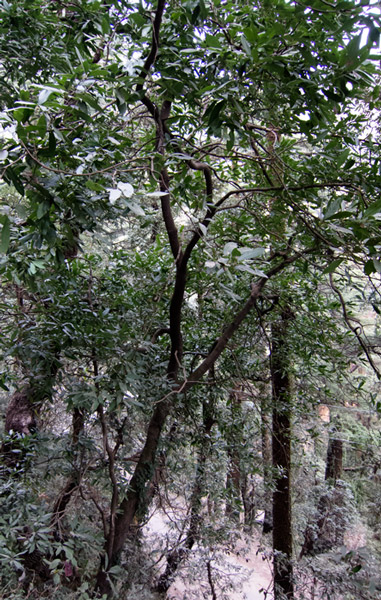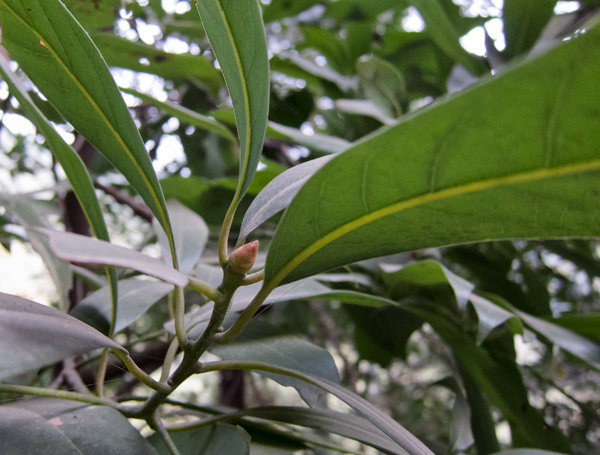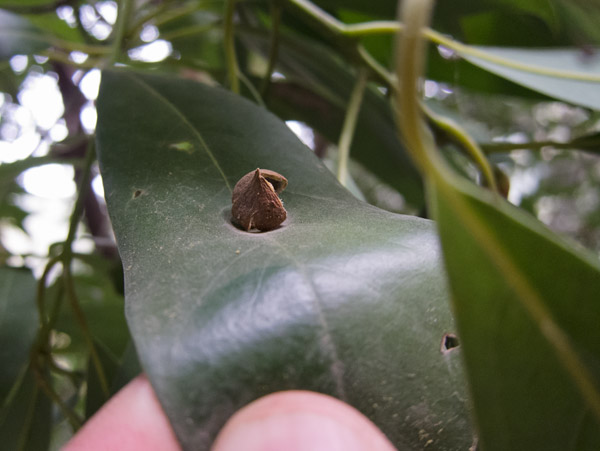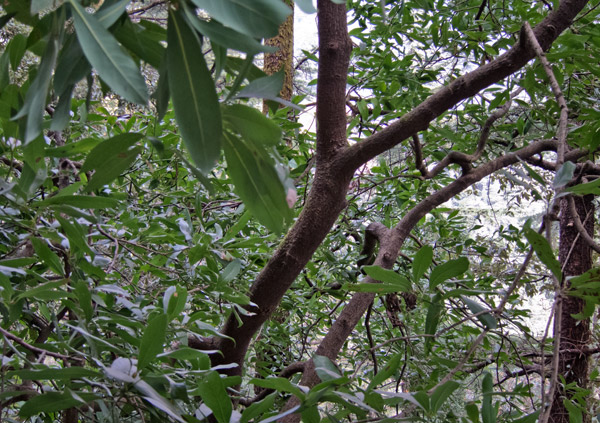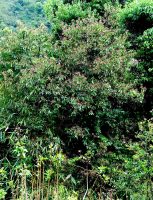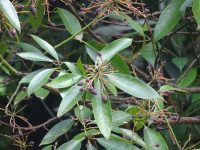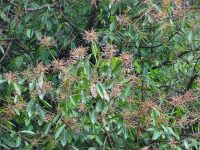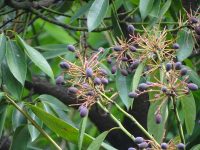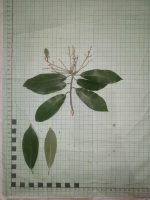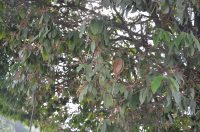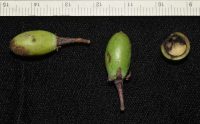|
Machilus odoratissima Nees, Pl. Asiat. Rar. 2: 70 1831. (syn: Laurus bombycina Buch.-Ham. ex Wall.; Laurus champa Buch.-Ham. ex Wall.; Laurus indica Lour.; Laurus odoratissima Wall.; Machilus indica Kurz; Machilus madang Miq.; Persea odoratissima (Nees) Kosterm.) as per Catalogue of Life; Tree for ID : Sattal,Uttarakhand : 310313 : AK-3 : Attachments (5). 6 posts by 4 authors.
A huge tree near the Sattal Lake, with tiny yellowish-green flowers. Kindly id. It could be Persea sp To me it seems Persea odoratissima (Lauraceae) which grow in this area and common. SK1834 07 April 2019 : 13 posts by 4 authors. Attachments (6)- around 900 kb each.
Location: Swoyambhu, Kathmandu, Nepal
Date: 27 March 2019
Elevation : 1400 m.
Habit : May be Wild
wild but considered sacred? is it in temple grounds? It looks like Alseodaphne semecarpifolia Nees
Not sure since since it is not listed in Nepal. What Lauraceae species are found in Nepal? I am just going on what I can see of the flowers, the red peduncles, colour of new foliage etc. A Persea species, then seems more likely.
My apologies for wasting time with mere guesswork. Pl. check.
Cannot not decide …!
I guess its Persea and more likely P gamblei. Probably you have already checked this. I will go for Machilus odoratissima Nees, as per details and references herein. Thank you … I guess matching.
Syn : Persea odoratissima (Nees) Kosterm. Another Tree for ID/ABDEC27 : 3 posts by 2 authors. Attachments (8)
This medium size tree is the only sample I have seen so far (I will probably see more once I know its identity). I first noticed it last summer when I saw abnormal growth on several of its leaves. The growth is still there but it is brown and brittle in stead of pink and firm. The bruised leaves have a strong betel like smell. Please help identify it.
Mcleodganj, Dharamshala, HP
12 December 2014
Looking lauraceae member 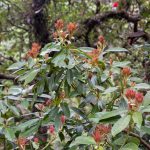  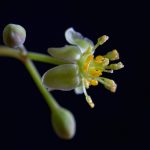 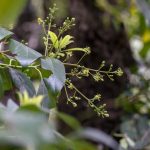 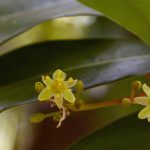  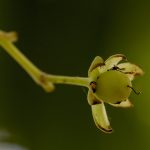 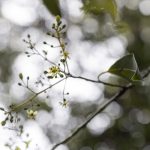  Thank you for resurfacing this, I had the opportunity to see the tree in flower last year and think it is likely to be Machilus odoratissima. Here are a few images to support my ID. 9 images. Machilus? I think it could be Machilus odoratissima. To me also appears close to images at Machilus odoratissima Nees and also as per comparative images at Machilus. I agree with you.   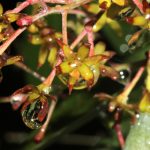  Persea odoratissima from Chopta Uttarakhand-GS06112021-1: 4 images. Persea odoratissima (King ex Hook.f) Kostermans
The species distinguished from another West Himalayan species in coriaceous leaves having 7-13 pairs of nerves, sepals oblong, reflexed in fruit, fruit ellipsoid up to 15 mm long, 7 mm broad. Accepted name Machilus odoratissima Nees Now it is Machilus odioratissima. .
Location: Bhalkot, Baglung, West Nepal
Date: 30 May 2023
Elevation 800m.
Habit : Wild
Which Lauraceae If the leaves and inflorescences are glabrous, then you can think of Machilus odoratissima. Correct Nepali Names : भाटे काउलो Bhaate Kaaulo / सेतो काउलो Seto Kaaulo .
Machilus odoratissima Nees Yes, id suggested by …, appears close as per images at If the inflorescences are glabrous, the yes, Machilus odoratissima. Lauraceae for ID Persea ?? AT MAR 2017/16: 15 posts by 4 authors. Attachments (5)
Kindly suggest Cross sections Attachments (2) I have also seen this tree, in Mussoorie and in Chakrata area, the input received is a conflict between the two, Neolitsea pallens and Persia duthei… all due to the fact that I could not record flower pics on any of the occasions..!!! …, I have photographs of fruits of Neolitsea pallens with me. I had photographed them in 2015 & 2016. I was was successful in clicking the plants in flowering stage this year. Here this plant flowers in February when no other tree is in flowering stage in Shimla. Even herbaceous plants are not in flowering except Viola canescens, Valerians jatamansi and Ainslea aptera. Pl. see fruits of Persea duthiei at I am now in a position to comment on the images of the supposed Persea species posted by you under this thread. Let us start with the generic identity. Well, Persea is a poorly defined genus, and especially it is difficult to distinguish it from the segregate genus Machilus. However, we may observes the paniculate-cymose type of infructescences, 6 tepals persistent at the base of the fruits which are spreading to reflexed (a cupule is absent). The leaves are alternate or slightly clustered, pinnately veined and glaucous on the undersurface. These characters conform to the genus Persea Mill. as defined by Werff (in Blumea 46: 125-140. 2001). In absence of a taxononic revision, we have to depend on the available floristic treatments. I find that the images posted by you closely match with Persea duthiei (King ex Hook.f.) Kosterm., described from your area but your photographs are not of P. duthiei. If we consult the protologue of this species and the images of the type materials housed in the Kew herbarium (http://apps.kew.org/herbcat/) and particularly the image at (http://apps.kew.org/herbcat/K000228447) we find that the fruits are subglobose and noted to be half inch in diam. (in the protologue) and ca 10 mm in diam. (as on the type specimens).
Then what is the identity of your plant? The fruits in your plant are clearly ovoid-ellipsoid and probably much larger in size than in P. duthiei and I also find that the lateral nerves of leaves are fewer in number. Hence I feel that the present images are very interesting and need to be studied in detail. You may please collect plenty of herbarium specimens both in flowering and fruiting and study in detail. The images are not matching with any species of Persea described so far from India and adjoining areas.
Thank you, … I’ll ask someone from Solan area to collect specimens for me. I clearly hinted that this plant is a hitherto unrecognized species of Persea and therefore think that it should be described as a new species after thorough investigation following usual procedure. Can I send dried specimens to you for further action? You are most welcome. Please also attach herbarium labels with the specimens so that they can be deposited in herb. CAL in due course when the studies on them are over. Please use some hard board so that the specimens are not damaged during transit. Pl. also check with images at Ocotea lancifolia (Schott) Mez although I am doubtful.
Thank you, … I have this plant with me. I have kept it with its old name Persea angustifolia. Thank you for familiarizing me with new name. … was supposed to send me dried specimens for further studies but he changed his mind. I have not changed my mind, but wanted to collected some more samples, for detailed studies. Secondly, our schedule is very tight (28 hours of teaching per week as against 14 hours suggested by UGC for associate professors) during July-Sept as final semester exams start in October here in H.P. I’ll send, what ever I have collected, within 3-4 days. Kindly guide me on my mail (…) as I have no practical training in taxonomy. Can it be Persea odoratissima as per http://manipurforestflora.co.in/specimen/ To me appears close to images at Machilus odoratissima
Pl. validate.
Not matching with Machilus odoratissima. Leaves size and fruits are different. Could it be finally identified? I think it is neither Persea duthei nor P. odoratissima
P. duthei is characterized by leaves with 12-20 pairs of nerves, linear-oblong sepals, spreading in fruit and globose fruits.
Persea odoratissima with coriaceous leaves having 7-13 pairs of nerves, sepals oblong, reflexed in fruit, fruit ellipsoid up to 15 mm long, 7 mm broad.
I hope my two uploads are correctly identified
Persea duthei from Uttarakhand pl Validate-GS06112021-2 (google.com)
If so the above plant is different in lighter coloured leaves with few veins and ellipsoid fruits (like P. odoratissima) but spreading sepals in fruit (like P. duthei), which are, however much narrower. As … suggests, we may have to look for some other species. This is still unidentified and may be interesting. Genus Persea is restricted to South America and the Indian species belong to Machilus. This looks like a cultivated sp., is it ?
Not cultivated, Sir I guess it is very close to Machilus odoratissimus Nees syn : Persea odoratissima (Nees) Kosterm. http://www.floraofnepal.org/onlineflora?wildcard=8485 ?? Now, it seems to be correctly identified. I hope … agrees with id as Machilus odoratissimus Nees syn : Persea odoratissima (Nees) Kosterm. (as suggested by …)
I think yes, Machilus odoratissima. .
Location: Godawari, Lalitpur
Date: 07 June 2024
Altitude: 1698m..
Habitat : Wild I think yes. . Sattal May 2025 :: Tree for ID :: ARK2025-026: 1 high res. images. This was clicked in at Sattal near Nainital, Uttarakhand in May 2025.
This is the lone pic I have.
Requested to please provide ID.
Is it some Machilus species?
Machilus odoratissimus Nees . Sattal May 2025 :: Tree for ID :: ARK2025-039: 1 high res. image. Machilus odoratissima Nees
. References:
Catalogue of Life The Plant List Ver.1.1 (Persea odoratissima (Nees) Kosterm.) Tropicos IPNI Flora of Pakistan FoP illustration Flora of Nepal Flowers of India ICIMOD
|
Machilus odoratissima
Updated on August 4, 2025


